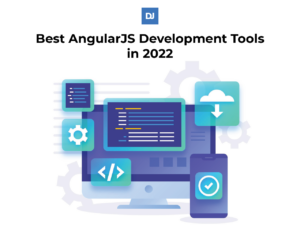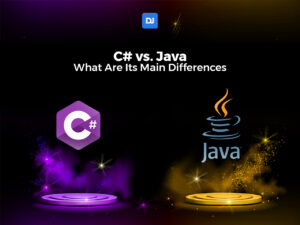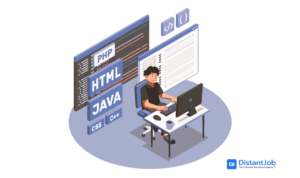You’ve come up with a genuine idea of an app that can improve people’s lives, and you’ve decided to go forth and try to implement it. But software development, particularly app development, is a complicated subject for the uninitiated that warrants some investigation before delving in, especially when you’re dealing with a sensitive issue like people’s health.
In this article, we’ll go over the major considerations concerning how to develop a health app and provide you with a 5 step process to get you going. Let’s begin!
5 Steps to Build a Health App
How to make a medical app? The process closely resembles the development of any other mobile app, but some specific considerations should be kept in mind. Let’s go over the entire process.
1. Choose your Specialization and Analyze your Competition
The medical field encompasses a nearly limitless number of diseases and habits your app can diagnose or track. So, you need to define exactly what kind of app yours will be and what it will focus on.
The first step when building a health app and planning for its success is to determine the niche you’re trying to cater to. Make sure to conduct ample research on the market for apps that are closely related to your idea and analyze if what you’re trying to build is unique and useful enough that users will want to adopt your app. Otherwise, you may end up with an app that will be ignored when faced with competition.
2. Decide and Research your Target Audience
The functionality of the app is just one facet you’ll have to focus on. The target audience is also a key factor to consider when designing the app: different audiences will demand different needs and features even within the same type of application.
Here are some key considerations when deciding your app’s users and their conditions when using the app:
- Age range
- Sex
- The level of medical knowledge the user has (professional/layman)
- The ideal physical condition to use the app (sitting/standing, with one hand/two hands, etc.)
You can also conduct interviews with specific patients that will help you hone in on their specific needs.
All of these factors will play out when deciding the best way to create a medical app and plan its features.
3. Design the App
Now that you know what you want your app to be about, it’s time to determine exactly how to develop a medical app. Use your research to help you make decisions about the app’s design and user experience. Make it as simple as possible: when it comes to health, people don’t want to feel overwhelmed. Provide a simple and clean interaction that minimizes the risk of errors. This is especially important when your target demographic is impaired in some way.
During this process, it’s important to assure compliance with the health regulations of the places you expect your app to operate. In the USA, you’ll be required to follow HIPAA Regulations, while in Europe, you’ll need to comply with the GDPR if the app collects personal information.
4. Develop your MVP
Now that the design is finalized, it’s time to assemble a team and develop your Minimum Viable Product (MVP).
At this stage, other questions become important to answer, and none more so than the type of technology you’ll use to develop it. You can opt for native technologies at the expense of project time and budget or opt for hybrid technologies that allow developers to create an app for several operative systems at once with a single code base. The performance loss is negligible compared to native, but if you are developing an app for real-time health tracking, you may want to devote the extra time and resources and develop native code instead.
You may be asking, “How much does it cost to develop a healthcare app?” and “How long does it take to develop a healthcare app?”. While the answer will depend on several factors, we have a detailed cost breakdown that you can use for your estimates on how to develop a health care app.
5. Test your MVP with a select group of your target audience
With the MVP in hand, it’s time to test it with a sample of your target audience. Depending on the size and complexity of the app, you may want several test groups to test different functionality. Collect their feedback and use it to further tweak and make changes to the app.
Remember: at this stage, you want to make changes related to the functionality and user experience. You are testing to see if your app idea works on a grander scale. Smaller details and optimizations should be noted but only further developed when the app’s viability is assured and the app goes into full production.
What is a Healthcare App?
A healthcare app can have many facets and serve multiple purposes. The main goal shared among them is the drive to improve people’s health one way or another. This can manifest in many ways, either by promoting healthy habits, keeping track of a person’s medication, or making communication with a health professional easier. The possibilities are endless!
Healthcare Apps come in two different broad categories: Patient Apps and Professional Apps.
Patient Apps
Patient Apps are targeted toward the general population, and their purpose is to either foster healthy habits or help diagnose early-stage diseases. Examples of such apps include:
- Fitness Apps
- Dieting Apps
- Medicine/Habits Reminder Apps
- Self-diagnosing Apps
- Medical Education Apps
Professional Apps
Professional apps, as the name implies, are targeted toward health professionals, such as doctors and nurses. Examples include:
- Appointment Management Apps
- Medical and Health Records Apps
- Medical Reference/Database Apps
- Doctor Networking Apps
- Patient Health Tracking Apps
- Telemedicine Apps
Why are Healthcare Apps Useful?
Healthcare apps can vastly improve a patient’s quality of life in many ways, depending on the type of app:
- They can promote healthy eating and living habits.
- Patients can receive medical care and be followed by professionals remotely. This is especially important for people with low mobility or immunity disorders that can easily get sick when getting out of their homes.
- Patients can keep up to date with their medication and treatments and not miss out due to forgetfulness.
As for professionals, health apps can be useful in other ways:
- Doctors can keep up to date with their patient’s conditions and change their treatments accordingly.
- Easier scheduling of consultations and follow-ups.
- Doctors can more easily share knowledge and help each other diagnose conditions.
Advantages of Medical Apps
Developing a health app is about improving patients’ and medical professionals’ lives and bringing them closer together. This can translate into several advantages, depending on which side of the fence you are:
Patients
- Improved Quality of Life: Health apps have the potential to introduce changes in a patient’s daily routine that can vastly improve their quality of life, from exercising to dieting.
- Better Treatment: Health apps can help patients stay on top of their treatments, providing personalized care and keeping them from forgetting medicine dosages. They can also provide helpful tips for other physical procedures to prevent accidents and further injuries during recovery.
- More affordable healthcare: Apps allow health professionals to provide a better service at greater convenience for both parties, decreasing the use of resources and time. This brings many advantages, but none more so than decreased prices across the board.
Professionals
- Improved Diagnosis and decision-making: A health app can be a powerful tool for professionals to zero in on a correct diagnosis faster by providing peer-reviewed and up-to-date information on symptoms and diseases, as well as treatment and medicine.
- Better workload distribution: A health app’s automated systems can alleviate professionals from mundane and repetitive tasks such as scheduling appointments and let them focus on treating their patients.
- Better resource allocation and use: By automating mundane systems, health apps can also be great allies to improve resource use by tracking equipment use and distributing it optimally to serve as many patients as possible.
The Initial Development Phase is Over. Now What?
Congratulations! You’ve managed to develop an MVP that people resonate with and are eager to use. But your journey to develop a healthcare app has only just begun.
What makes a health app successful?
Much like any other app in the market nowadays, the best apps are the ones that provide a core functionality that their users cannot live without while at the same time improving continually with user feedback.
Keeping an app up to date is no longer a luxury but a necessity. With competitor apps appearing every day, it’s important to stand out from the crowd and keep your current users happy so they don’t feel the need to change.
How do health apps make money?
Health apps primarily make money by two methods:
- One-time purchase: You have a price tag on your app or a transaction that, when bought, will unlock all the app’s functionality.
- Recurrent Subscription: The users will pay a periodic fee to unlock features in the app. You can have tiered subscription packages that unlock different features. This can be a viable strategy when your app offers several features that people wouldn’t want to use in their totality but would rather pick and choose which they need.
Unlike other mobile apps, medical apps shouldn’t use ads as their monetizing strategy. Health app users can get turned off by them for several reasons, but the two main ones are:
- They may fear for their confidential information: Ads are usually associated with tracking information to target users, and you do not want them to doubt the confidentiality of their extremely personal information.
- Ads can be detrimental to your app’s image: You can’t, for the most part, control the types of ads your app will show, and you run the risk of showing ads that can be contradictory to your message (an app that promotes healthy diets would look very bad promoting fast food chains, for example).
Conclusion
You now know the main steps on how to create a health app. It’s a more involved process than creating a normal app, but it has far more potential to resonate with people. A good health app becomes a personal companion to its users, improving their quality of life and becoming a staple in their daily routine.
If you are looking to hire developers to develop a health app for you, DistantJob can help you find the best mobile developers, be it iOS or Android. If you’d rather develop a Hybrid app, we also have several expert developers in Xamarin and Flutter that can see your vision become a reality. We have a strict vetting process and will be sure to find you the most qualified developers that also fit in with your company culture.





